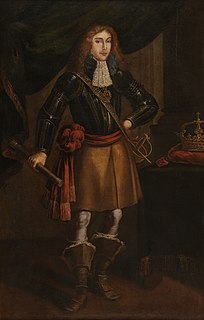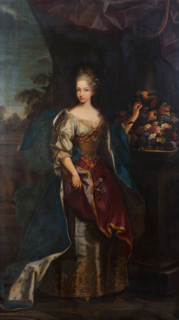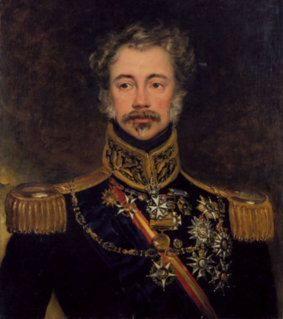Contents
Part of a series on the |
|---|
| History of Portugal |
 |
| Timeline |
| |
This is a historical timeline of Portugal.
| History of Portugal |
|---|
 |
| Timeline |
| |
This is a historical timeline of Portugal.

Afonso VI, known as "the Victorious", was the second King of Portugal of the House of Braganza from 1656 until his death. He was initially under the regency of his mother, Luisa of Medina-Sidonia, until 1662, when he removed her to a convent and took power with the help of his favourite, the Count of Castelo Melhor.

Dom John VI, nicknamed "the Clement", was King of the United Kingdom of Portugal, Brazil and the Algarves from 1816 to 1825. Although the United Kingdom of Portugal ceased to exist de facto beginning in 1822, he remained its monarch de jure between 1822 and 1825. After the recognition of the independence of Brazil under the Treaty of Rio de Janeiro of 1825, he continued as King of Portugal until his death in 1826. Under the same treaty, he also became titular Emperor of Brazil for life, while his son, Emperor Dom Pedro I, was both de facto and de jure the monarch of the newly independent country.

The Liberal Wars, also known as the Portuguese Civil War, the War of the Two Brothers or Miguelite War, was a war between liberal constitutionalists and conservative absolutists in Portugal over royal succession that lasted from 1828 to 1834. Embroiled parties included the Kingdom of Portugal, Portuguese rebels, the United Kingdom, France, the Catholic Church, and Spain.

Dom Joseph I, known as the Reformer, was King of Portugal from 31 July 1750 until his death in 1777. Among other activities, Joseph was devoted to hunting and the opera. Indeed, he assembled one of the greatest collections of operatic scores in Europe. His government was controlled by Sebastião José de Carvalho e Melo, 1st Marquis of Pombal.

Dona Maria I was Queen of Portugal from 24 February 1777 until her death in 1816. Known as Maria the Pious in Portugal and Maria the Mad in Brazil, she was the first undisputed queen regnant of Portugal and the first monarch of Brazil.

Dona Maria II "the Educator" or "the Good Mother", reigned as Queen of Portugal from 1826 to 1828, and again from 1834 to 1853. Born in Rio de Janeiro, she was the first child of Emperor Dom Pedro I of Brazil and Empress Dona Maria Leopoldina, and thus a member of the House of Braganza. One of the two surviving children born when Pedro was still heir apparent to Portugal, she inherited Portuguese titles and was placed in the line of succession to the former Portuguese throne, even after becoming a member of the Brazilian Imperial Family, from which she was excluded in 1835 after her definitive ascension to the Portuguese throne.

DomMiguel I, nicknamed "the Absolutist", "the Traditionalist" and "the Usurper", was the King of Portugal between 1828 and 1834, the seventh child and third son of King John VI and his queen, Carlota Joaquina of Spain.

The Most Serene House of Braganza, also known as the Brigantine Dynasty, is a dynasty of emperors, kings, princes, and dukes of Portuguese origin which reigned in Europe and the Americas.

DomDuarte Nuno, Duke of Braganza was the claimant to the defunct Portuguese throne, as both the Miguelist successor of his father, Miguel, Duke of Braganza, and later as the head of the only Brigantine house, after the death of the last ruling Braganza, King Manuel II of Portugal. In 1952, when the Portuguese Laws of Banishment were repealed, the Duke moved his family to Portugal, thus returning the Miguelist Braganzas to their homeland and becoming the first of the former Portuguese royal dynasty to live in Portugal since the abolition of the monarchy, in 1910.

José Lúcio Travassos Valdez, only Baron and first Count of Bonfim, was a Portuguese soldier and statesman.

The history of the kingdom of Portugal and the Algarves, from the First Treaty of San Ildefonso and the beginning of the reign of Queen Maria I in 1777, to the end of the Liberal Wars in 1834, spans a complex historical period in which several important political and military events led to the end of the absolutist regime and to the installation of a constitutional monarchy in the country.

Dona Maria Francisca Isabel of Savoy was Queen of Portugal during her marriage to King Dom Afonso VI from 2 August 1666 to 24 March 1668 and, as the wife of Afonso's brother King Dom Peter II, from 12 September 1683 until her death in December that year. She married Afonso VI at the age of 20; because the marriage was never consummated, she was able to obtain an annulment. On 28 March 1668, she married the King's brother Infante Dom Peter, Duke of Beja, who was appointed prince regent the same year due to Afonso's perceived incompetence. She became queen a second time when Afonso died and Peter succeeded his brother, but she herself died three months later.

The Palace of Queluz is an 18th-century palace located at Queluz, a city of the Sintra Municipality, in the Lisbon District, on the Portuguese Riviera. One of the last great Rococo buildings to be designed in Europe, the palace was conceived as a summer retreat for Dom Pedro of Braganza, later to become husband and then king consort to his own niece, Queen Maria I. It served as a discreet place of incarceration for Queen Maria as her descent into madness continued in the years following Dom Pedro's death in 1786. Following the destruction by fire of the Ajuda Palace in 1794, Queluz Palace became the official residence of the Portuguese prince regent John VI, and his family and remained so until the royal family fled to the Portuguese colony of Brazil in 1807 following the French invasion of Portugal.

The Portuguese Restoration War was the war between Portugal and Spain that began with the Portuguese revolution of 1640 and ended with the Treaty of Lisbon in 1668, bringing a formal end to the Iberian Union. The period from 1640 to 1668 was marked by periodic skirmishes between Portugal and Spain, as well as short episodes of more serious warfare, much of it occasioned by Spanish and Portuguese entanglements with non-Iberian powers. Spain was involved in the Thirty Years' War until 1648 and the Franco-Spanish War until 1659, while Portugal was involved in the Dutch–Portuguese War until 1663.

Dom Luís de Vasconcelos e Sousa, 3rd Count of Castelo Melhor was a Portuguese politician and prime minister.

The Liberal Revolution of 1820 was a Portuguese political revolution that erupted in 1820. It began with a military insurrection in the city of Porto, in northern Portugal, that quickly and peacefully spread to the rest of the country. The Revolution resulted in the return in 1821 of the Portuguese Court to Portugal from Brazil, where it had fled during the Peninsular War, and initiated a constitutional period in which the 1822 Constitution was ratified and implemented. The movement's liberal ideas had an important influence on Portuguese society and political organization in the nineteenth century.

João Carlos Gregório Domingos Vicente Francisco de Saldanha Oliveira e Daun, 1st Duke of Saldanha, was a Portuguese marshal and statesman.

The Pantheon of the House of Braganza, also known as the Pantheon of the Braganzas, is the final resting place for many of the members of the House of Braganza, located in the Monastery of São Vicente de Fora in the Alfama district of Lisbon, Portugal. The pantheon's burials have included Portuguese monarchs, Brazilian monarchs, a Romanian monarch, queen consorts of Portugal, and notable Infantes of Portugal, among others.

The Descendants of Miguel I of Portugal, of the House of Braganza, were numerous and left a lasting mark on European royalty. Miguel married Princess Adelaide of Löwenstein-Wertheim-Rosenberg and the strategic marriages for all of their children into various European royalties would earn Miguel the nickname of Grandfather of Europe.